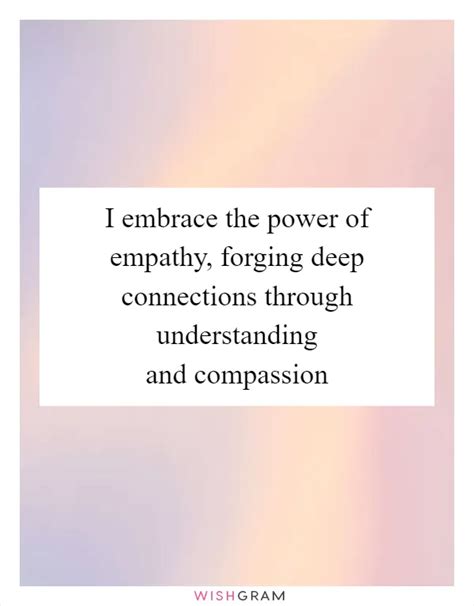In an era marked by rapid technological advancements and relentless competition, the ability to genuinely connect with others has become an invaluable asset. As we navigate the complexities of the modern world, empathy emerges as a transformative force, empowering us to bridge gaps, foster understanding, and build meaningful relationships.

The Transformative Nature of Empathy
Empathy, the ability to understand and share the feelings of others, transcends mere sympathy. It involves immersing oneself in another’s perspective, perceiving their emotions, and acknowledging their experiences. By embracing empathy, we cultivate a profound sense of human connection and create a foundation for effective communication.
According to a study by the University of California, Berkeley, individuals who exhibit high levels of empathy demonstrate improved problem-solving abilities, enhanced decision-making skills, and increased resilience in the face of adversities. Empathy fosters an environment of compassion, trust, and understanding, enabling us to build stronger bonds with colleagues, family members, and even strangers.
Pain Points of Lacking Empathy
The absence of empathy can lead to several communication barriers and interpersonal challenges. People who lack empathy often struggle to:
- Understand the needs and perspectives of others
- Communicate effectively and build rapport
- Resolve conflicts peacefully
- Foster a sense of community and belonging
This lack of empathy can create a culture of indifference, hinder collaboration, and undermine productivity. Studies show that workplaces with low levels of empathy experience higher rates of turnover, lower employee morale, and reduced overall performance.
Motivations for Cultivating Empathy
The benefits of cultivating empathy are undeniable. By developing our empathic capabilities, we:
- Improve our communication skills and build stronger connections
- Increase our resilience and adaptability in challenging situations
- Foster a culture of compassion and understanding in our communities
- Create a more harmonious and inclusive society
Understanding these motivations serves as a powerful catalyst for embracing empathy and reaping its transformative benefits.
Effective Strategies for Cultivating Empathy
Cultivating empathy is not a passive process; it requires conscious effort and practice. Here are some effective strategies to develop this essential skill:
- Active Listening: Engage in deep listening, paying attention not only to the words being spoken but also to the unspoken emotions and needs behind them.
- Perspective-Taking: Practice stepping into the shoes of others, considering their viewpoints and experiences to gain a deeper understanding of their perspectives.
- Emotional Attunement: Develop self-awareness and emotional intelligence to recognize and regulate your own emotions and connect with the emotions of others.
- Compassionate Communication: Express yourself with empathy and understanding, using language that conveys care and concern for the feelings of others.
- Mindful Interactions: Practice mindfulness in your interactions, paying attention to the present moment and cultivating a non-judgmental attitude towards others.
Tips and Tricks for Enhancing Empathy
In addition to the strategies mentioned above, consider these practical tips and tricks to enhance your empathy:
- Engage in Perspective-Reversal Exercises: Regularly challenge your own perspectives by actively seeking out and considering viewpoints that differ from your own.
- Foster a Growth Mindset: Approach empathy as a skill that can be learned and developed over time, instead of a fixed trait.
- Use Empathy-Building Tools: Leverage technology and resources such as empathy maps, scenario-based simulations, and emotional intelligence assessments to facilitate empathy development.
- Seek Feedback and Practice Regularly: Engage in reflective practice, soliciting feedback from others on your empathic skills and actively practicing these skills in real-life situations.
- Incorporate Empathy into Leadership: Leaders can create a culture of empathy by modeling empathic behaviors, providing opportunities for perspective-taking, and fostering open and inclusive communication.
New Applications for Empathy
Beyond interpersonal communication, empathy holds immense potential for innovation in various fields. Here’s a creative new word to generate ideas for new applications:
Empathize: A process of merging empathy with technology to create innovative solutions that leverage the power of human connection.
Useful Tables
Table 1: Benefits of Cultivating Empathy
| Benefit | Description |
|---|---|
| Improved Communication | Increased understanding, rapport, and conflict resolution |
| Enhanced Resilience | Greater adaptability and well-being during challenges |
| Fostered Compassion | Increased empathy for others and a culture of understanding |
| Productive Workplaces | Reduced turnover, higher morale, and improved performance |
Table 2: Pain Points of Lacking Empathy
| Pain Point | Description |
|---|---|
| Misunderstandings | Difficulty comprehending needs and perspectives |
| Communication Barriers | Impaired ability to connect and build rapport |
| Conflict Escalation | Inability to resolve conflicts effectively |
| Alienation | Reduced sense of belonging and inclusion |
Table 3: Effective Empathy-Cultivating Strategies
| Strategy | Description |
|---|---|
| Active Listening | Deep listening and attention to unspoken emotions |
| Perspective-Taking | Stepping into others’ shoes to understand their viewpoints |
| Emotional Attunement | Recognizing and regulating own emotions and connecting with others’ emotions |
| Compassionate Communication | Using language that conveys care and understanding |
| Mindful Interactions | Paying attention to the present moment and avoiding judgment |
Table 4: Tips and Tricks for Enhancing Empathy
| Tip | Description |
|---|---|
| Perspective-Reversal Exercises | Seeking out and considering opposing viewpoints |
| Growth Mindset | Approaching empathy as a learnable skill |
| Empathy-Building Tools | Using technology and resources to facilitate empathy development |
| Feedback and Practice | Reflecting on empathic skills and practicing in real-life situations |
| Empathy in Leadership | Leaders modeling empathic behaviors and fostering an inclusive environment |
